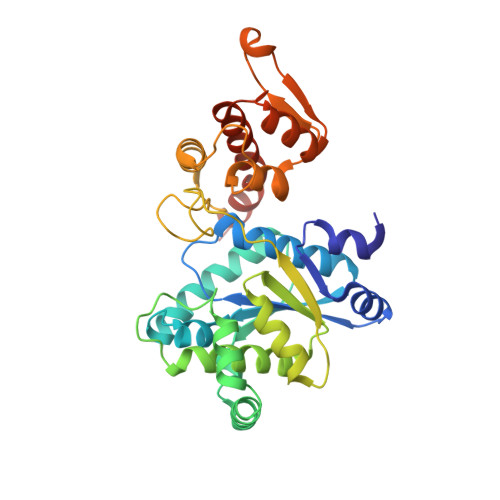Structural Basis for the Specific Cotranslational Incorporation of p-Boronophenylalanine into Biosynthetic Proteins.
Schiefner, A., Nastle, L., Landgraf, M., Reichert, A.J., Skerra, A.(2018) Biochemistry 57: 2597-2600
- PubMed: 29668275
- DOI: https://doi.org/10.1021/acs.biochem.8b00171
- Primary Citation of Related Structures:
5N5U, 5N5V - PubMed Abstract:
The site-specific incorporation of the non-natural amino acid p-boronophenylalanine (Bpa) into recombinant proteins enables the development of novel carbohydrate-binding functions as well as bioorthogonal chemical modification. To this end, Bpa is genetically encoded by an amber stop codon and cotranslationally inserted into the recombinant polypeptide chain at the ribosome by means of an artificial aminoacyl-tRNA synthetase (aaRS) in combination with a compatible suppressor tRNA. We describe the crystal structure of an aaRS specific for Bpa, which had been engineered on the basis of the TyrRS from Methanocaldococcus jannaschii, in complex with both Bpa and AMP. The substrates are bound in an orientation resembling the aminoacyl-AMP mixed anhydride intermediate and engaged in a network of four hydrogen bonds that allows specific recognition of the boronate moiety by the aaRS. The key determinant of this interaction is the coplanar alignment of its Glu162 carboxylate group with Bpa, which results in a double hydrogen bond with the boronic acid substituent. Our structural study elucidates how a small set of five side chain exchanges within the TyrRS active site can switch its substrate specificity to the hydrophilic amino acid Bpa, thus stimulating the reprogramming of other aaRS to recruit useful non-natural amino acids for next-generation protein engineering.
Organizational Affiliation:
Lehrstuhl für Biologische Chemie , Technische Universität München , 85354 Freising (Weihenstephan) , Germany.















